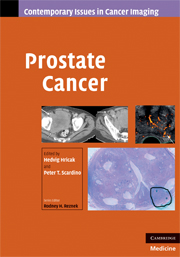Book contents
- Frontmatter
- Contents
- Contributors
- Series Foreword
- Preface
- 1 Anatomy of the prostate gland and surgical pathology of prostate cancer
- 2 The natural and treated history of prostate cancer
- 3 Current clinical issues in prostate cancer that can be addressed by imaging
- 4 Surgical treatment of prostate cancer
- 5 Radiation therapy
- 6 Systemic therapy
- 7 Transrectal ultrasound imaging of the prostate
- 8 Computed tomography imaging in patients with prostate cancer
- 9 Magnetic resonance imaging of prostate cancer
- 10 Magnetic resonance spectroscopic imaging and other emerging magnetic resonance techniques in prostate cancer
- 11 Nuclear medicine: diagnostic evaluation of metastatic disease
- 12 Imaging recurrent prostate cancer
- Index
- Plate section
- References
4 - Surgical treatment of prostate cancer
Published online by Cambridge University Press: 23 December 2009
- Frontmatter
- Contents
- Contributors
- Series Foreword
- Preface
- 1 Anatomy of the prostate gland and surgical pathology of prostate cancer
- 2 The natural and treated history of prostate cancer
- 3 Current clinical issues in prostate cancer that can be addressed by imaging
- 4 Surgical treatment of prostate cancer
- 5 Radiation therapy
- 6 Systemic therapy
- 7 Transrectal ultrasound imaging of the prostate
- 8 Computed tomography imaging in patients with prostate cancer
- 9 Magnetic resonance imaging of prostate cancer
- 10 Magnetic resonance spectroscopic imaging and other emerging magnetic resonance techniques in prostate cancer
- 11 Nuclear medicine: diagnostic evaluation of metastatic disease
- 12 Imaging recurrent prostate cancer
- Index
- Plate section
- References
Summary
Introduction
Prostate cancer is the most common cancer and the second most common cause of cancer-related death of American men [1]. The American Cancer Society estimates that 186,320 new cases of prostate cancer will be diagnosed and that 28,660 men will die from this disease in the United States in 2008 [2]. The widespread use of prostate-specific antigen (PSA) for prostate cancer screening has led to a substantial decrease in stage at time of diagnosis. Data from the National Cancer Institute's Surveillance, Epidemiology, and End Results program reveal that 91% of diagnosed cancers in the period 1996–2002 were localized to the prostate [1], whereas only 80% are seen in series from previous years. The 5-year expected survival for prostate cancers diagnosed between 1996 and 2002 is 100%, up substantially from 76% between 1984 and 1986 [1]. With today's patients presenting at a younger age and with cancers at a lower stage and lower grade, the management of clinically localized prostate cancer has focused on decreasing the inherent morbidity and long-term consequences of specific therapies. Selecting the optimal therapeutic approach from an array of choices requires individualization of treatment plans based upon risk stratification, the effectiveness of the treatment, and the likelihood that a patient will experience a treatment-related complication.
Radical prostatectomy (RP) remains an excellent treatment option for men with clinically localized prostate cancer.
- Type
- Chapter
- Information
- Prostate Cancer , pp. 43 - 57Publisher: Cambridge University PressPrint publication year: 2008



